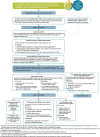9. Pharmacologic Approaches to Glycemic Treatment: Standards of Care in Diabetes-2024
- PMID: 38078590
- PMCID: PMC10725810
- DOI: 10.2337/dc24-S009
9. Pharmacologic Approaches to Glycemic Treatment: Standards of Care in Diabetes-2024
Erratum in
-
Erratum. 9. Pharmacologic Approaches to Glycemic Treatment: Standards of Care in Diabetes-2024. Diabetes Care 2024;47(Suppl. 1):S158-S178.Diabetes Care. 2024 Jul 1;47(7):1238. doi: 10.2337/dc24-er07a. Diabetes Care. 2024. PMID: 38696224 Free PMC article. No abstract available.
Abstract
The American Diabetes Association (ADA) "Standards of Care in Diabetes" includes the ADA's current clinical practice recommendations and is intended to provide the components of diabetes care, general treatment goals and guidelines, and tools to evaluate quality of care. Members of the ADA Professional Practice Committee, an interprofessional expert committee, are responsible for updating the Standards of Care annually, or more frequently as warranted. For a detailed description of ADA standards, statements, and reports, as well as the evidence-grading system for ADA's clinical practice recommendations and a full list of Professional Practice Committee members, please refer to Introduction and Methodology. Readers who wish to comment on the Standards of Care are invited to do so at professional.diabetes.org/SOC.
© 2024 by the American Diabetes Association.
Figures




References
-
- Diabetes Control and Complications Trial (DCCT)/Epidemiology of Diabetes Interventions and Complications (EDIC) Study Research Group . Mortality in type 1 diabetes in the DCCT/EDIC versus the general population. Diabetes Care 2016;39:1378–1383 - PubMed
-
- Lachin JM; DCCT/EDIC Research Group . Understanding metabolic memory: the prolonged influence of glycemia during the Diabetes Control and Complications Trial (DCCT) on future risks of complications during the study of the Epidemiology of Diabetes Interventions and Complications (EDIC). Diabetes Care 2021;44:2216–2224 - PMC - PubMed
-
- Holt RIG, DeVries JH, Hess-Fischl A, et al. . The management of type 1 diabetes in adults. a consensus report by the American Diabetes Association (ADA) and the European Association for the Study of Diabetes (EASD). Diabetes Care 2021;44:2589–2625 - PubMed
Publication types
MeSH terms
Grants and funding
LinkOut - more resources
Full Text Sources
Other Literature Sources
Medical
Research Materials

